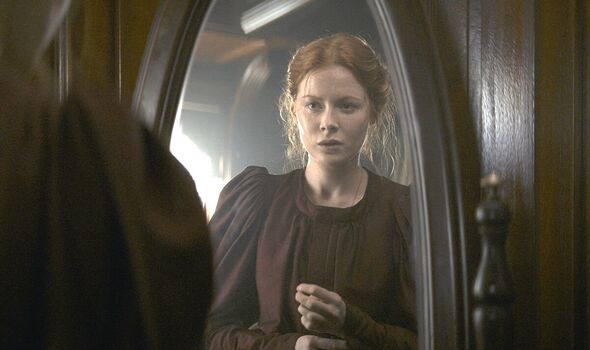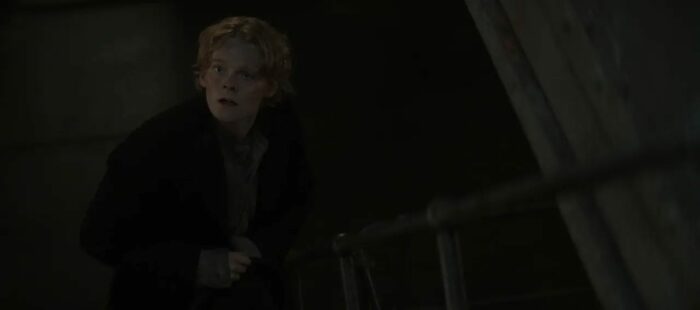The following contains spoilers for 1899 S1E1, “The Ship” (written by Jantje Friese & Baran bo Odar and directed by Barn bo Odar)
After the success of Dark, a series that was called “the most intelligent series of all time” by The Independent, the anticipation for 1899, showrunners Jantje Friese and Baran bo Odar’s latest offering for Netflix, was especially high. As a big fan of Dark, I was very excited for 1899 and yet I’d be lying if I said there was no trepidation—-would the pair be able to pull off another Dark-sized victory on behalf of intelligent, mystery box television?
On the basis of first episode (‘The Ship’), I would say that Friese and Odar have a very good chance at doing so. While more methodical in its pacing than Dark (yes, comparisons are inevitable), 1899‘s first episode contains a tension more brooding and claustrophobic than first felt in Dark, no doubt in part to 1899’s ship-bound setting, and this promises discoveries potentially darker and more harrowing than Dark (and that’s saying something!)
But what’s the story? What rabbit hole are we being led down this time?
Let’s jump in…
“What is Lost, Will Be Found”
The basic idea is deceptively simple on the surface: in 1899, four months after the disappearance of the passenger ship The Prometheus, another vessel from the same shipping company, a ship called Kerberos (Greek for Cerberus), is undertaking a journey to New York when it receives insistent transmissions of co-ordinates presumed to be from The Prometheus. Captain Eyk Larsen (Andreas Pietschmann), alongside mysterious passenger Maura Franklin (Emily Beecham) and other crew members, travel across to the ship, which is indeed The Prometheus, only to find the crew and passengers gone—all except an eerie little boy who was apparently locked in a cupboard, holding a mysterious black pyramid-shaped object…
Ok, so that last part isn’t so simple, and neither is the world of 1899 when you dig past the surface of what the world we’re presented with in this first episode, something which is readily reflected in the character of Maura Franklin.
Maura appears to be our central protagonist, and while the other characters within the show seem dressed in secrets, Maura is filled to the brim with mystery and then some. When we are first introduced to her, she is being dragged through a corridor it what appears to be some kind of oppressive institution—most likely a mental asylum. A strange, shadowy figure observes her from a distance, addressed by Maura as her father. She screams at him that she knows what he did to her brother after said sibling found out what their father had done on The Prometheus. And yet she can’t remember, the agony of which seems to tear through her.
Is her father sympathetic? No. He simply tells Maura to wake up and holds out a black pyramid, which then sends us, via the camera, travelling backwards and out through Maura’s eye and into…what? Another reality? A flashback? A dream? 1899 isn’t giving up its secrets this early, but what we do find out is that the Maura we see now is a passenger on Kerberos and she has a letter from her brother that she keeps secret:
I found out what our father did. Meet me in New York. Don’t trust anyone. Your brother.
As Maura’s quiet desperation increases in the wake of the discovery of The Prometheus, a picture easily forms: her brother was most likely on The Prometheus and sent the letter to Maura from there. He intended to meet her in New York to divulge his discovery but then The Prometheus became lost. Maura certainly hopes she will find her brother when she boards The Prometheus. She doesn’t find him, but then we’re back to the black pyramid from the start of the episode. The object is obviously significant: it bookends the episode, after all. But what does it relate to and does Maura recognise it?

On the back of the envelope containing the letter from Maura’s brother, it states “what is lost, will be found.” Maura hasn’t found her brother, but she has found the black pyramid. Was it lost? If so, who by? Another possibility is that Maura is finding herself. As she looked at herself in the mirror in her cabin on the Kerberos, she told herself her name, where she was from and what year it was. Was Maura trying to convince herself of her identity? Is she trying to create some sort of anchor (pun unfortunately intentional)? Or is this is a lie that she tells herself, and it is really herself she is trying to find?
Is Maura ultimately the one who is lost?
Wars of Race, Class and Gender
Elsewhere on the Kerberos, there is a simmering tension that sometimes expresses itself, but often insinuates itself in the background, ready to boil over. These tensions all pivot on issues of race, class and gender.
Early on in the episode, Maura is addressed in the dining room by a Mrs. Wilson, a shifty-acting woman who suggests as much as she actually says. It is revealed during the course of their conversation that Maura is a doctor and actually focuses her areas of expertise on the brain. However, Maura is not allowed to practice medicine in England, only study it, according to the gender ‘norms’ of the time. This brings out a (deserved) seething comment from Mrs. Wilson:
That’s what they do, don’t they? They show you the world and then they tell you can’t have it.
She then goes on to refer to a male, middle-aged doctor across the room, Dr. Reginald Murray. Even though he is far from a smart man, because he comes from a family line of doctors and he comes from money, he finds himself in a privileged position, one that will not be extended to a woman. Although there have been significant changes in gender equality since 1899, unfortunately, the picture painted here is one that is still very much recognizable. The more things change, the more things stay the same.
Through his privilege, Dr. Reginald Murray also gives an indication to the class conflict inherent in the ship. In the dining room, the monotonous routine of the middle classes is satirized by an entire room supping their tea and clinking their cups down on their saucers in unison. It reflects how the fragile structure of their society is held together by conforming and submitting to the convention of doing the ‘correct’, accepted thing at the right time. This tenuous harmony is violently disrupted by an outsider, an ‘other’, a Danish passenger named Krester who is clearly not allowed above deck (he is soon to be dragged away and locked up for his transgression). He is desperate, shouting for help for his pregnant girlfriend, and yet the entire room stares at him as if he is incomprehensible; not because they can’t understand his language, but because they can’t understand how he has betrayed his station in life by penetrating their sanctum like this. It is notable that the privileged Dr. Murray does not say a word and looks anywhere but at Krester. It is almost as if Krester doesn’t exist.

Below deck, another hierarchy exists within the ‘lower’ classes but is played out in terms of race. Here, the English engine crew takes out their frustrations on their international colleagues. The Polish member of the team, Olek, is the one sent to do the dirty job, to unblock a fuel shuttle, with his English colleague only referring to Olek’s race: ‘Polak’. It is as if it is not even worth the Englishman learning Olek’s name, but the fact that we do know Olek’s name and we never learn the Englishman’s is demonstrative of the show’s sympathies. As is the fact that it is Olek who crosses racial boundaries by sharing his bread with the hungry black Frenchman Jérôme. Even in the face of adversity and discrimination, boundaries can be overcome.
The Mind is as Deep as the Ocean
A curious element of this opening episode of 1899 is the show’s equating of the mind with the sea. The opening narration makes it explicit:
The brain is wider than the sky. For put them side by side, the one the other will contain with ease and you beside. The brain is deeper than the sea. For hold them blue to blue, the one the other will absorb.
At this point, the camera sends us right through the ocean into a whirlpool tunnel that brings us out into the asylum corridor with Maura. One could argue that perhaps here we have taken a trip into Maura’s mind, looking at a memory or perhaps the personification of a deep-rooted fear. Or that actually, this is Maura’s reality and when we join her on the Kerberos out at sea, that is the fantasy or the representation of a journey into the mind. The depths of the sea and the depths of the mind. It would make sense of the explanation Maura gives to Mrs. Wilson about her fascination with the brain: “The brain drives our thoughts, our behaviour. It holds all the secrets of the universe. There’s a hidden world inside each of us which only needs to be deciphered.” And perhaps it makes sense of Mrs. Wilson’s response: “Aren’t some things better left in the dark?” Is the fantasy designed to protect Maura from the truth or to help her find it?
Perhaps the final word on the subject should be given to Captain: “Right down here, the ocean has a depth of almost 4,000 meters. Man has mapped out every corner of this world. Been to the farthest deserts, the top of the highest mountains. But what’s down there is still a mystery, a hidden world in the shadows.”
On the evidence of ‘The Ship’, 1899 is here to bring light to the hidden shadows of the mysteries of the mind and the sea. Count me as an enthusiastic passenger.

